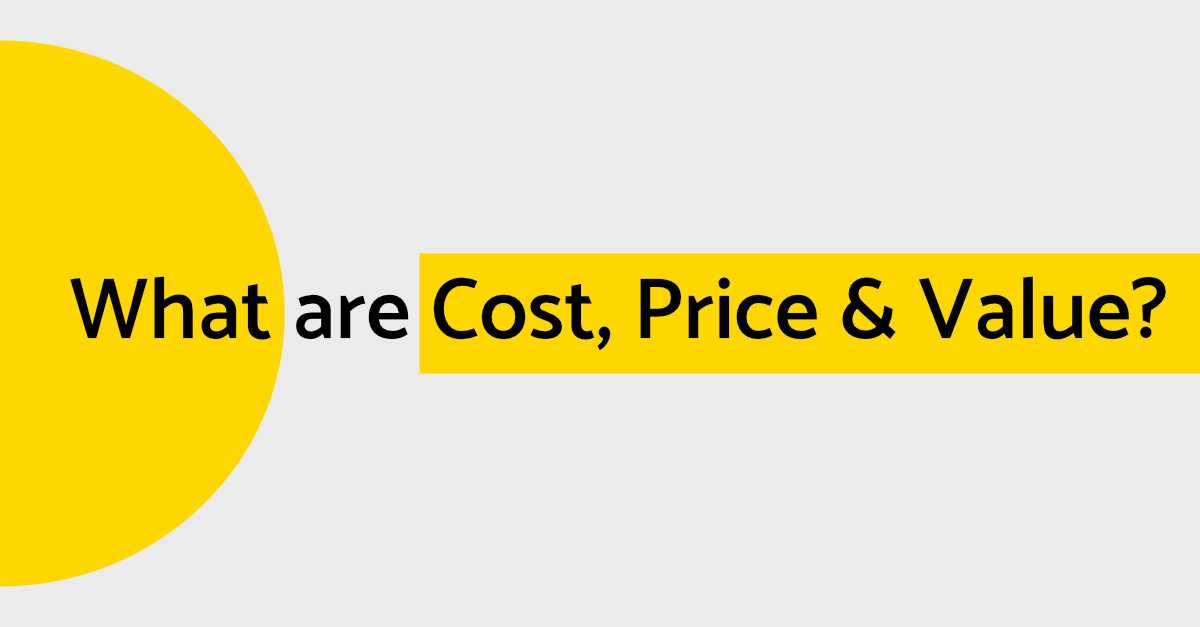There is often some confusion about the difference between cost, price and value. But value isn't always a monetary term, so what is value and how can you determine it?
You may have a customer come to you and ask, "How much does this cost?". What they really mean is "What is the price?". After you've told them, it's down to the customer to determine if the price matches the value they personally assign to the product or service.
Cost
Cost = Time (or Effort) + Materials
The amount spent to produce a product or service. This includes things like raw materials, salaries, rent, tax etc. You must know your costs, otherwise you could be losing money without realising!
A couple of extra things to consider here: You need to be aware that there is time associated with managing the various costs, and that is something you need to account for too in your costs. Plus, don't forget to include an amount for any equipment you use - even if you own it. Yes, even if you own it.
Let's say you use a laptop for your business, a laptop which allows you to purchase raw materials, create invoices, edit your website, contact customers, manage your social media, keep track of your finances, file your tax returns or self assement. All pretty important things, right? What if your laptop died tomorrow? You'd have to dive into your profits or personal savings and go and buy another one.. ouch.
How you could buy a new laptop without dipping into your profits...
If you added an additional amount, lets say 5%, to your costs, you could build up a reserve to cover yourself. Yes it may take a few sales to build up enough to actually pay for a new laptop, but eventually you'll get there (hopefully before your laptop dies - get planning!) and you wouldn't have to open up your savings or profits to cover the cost!
For example, imagine you had 20 different items you sold and they all currently (and conveniently) cost £10 each. You add 5% cost to each of those items, now you have 20 items that cost £10.50 each. A basic replacement laptop might cost £300, so in order to have enough to cover the cost of buying a new laptop you'd have to sell 30 of each of your 20 items and there's your £300 without eating into your profits.
If you've only recently bought a laptop, maybe you think it'll last 3 years, so you could spread this extra cost...
So now we could work it out differently, now let's say a £400 laptop because the cost may go up in 3 years, but actually we want to be able to afford this in 2 years because that's when our new warranty expires. We take £400 and divide it by 2 years, £200 per year we need to cover.
We sell on average 20 items per month, still costing £10 each, that's 240 sales a year. In order to make our £200 per year, we need to take that £200 and divide it between each of our year sales so we have £200 / 240 = 0.83p. So now our cost for each item is £10.83, and in 2 years we will have gained an additional £400 which covers our laptop. But if our laptop lasts 3 years, we'll have earned another year's worth giving us £600 to spend on a new laptop if we need to (assuming sales stay consistent every year).
Price
Price = Cost + Profit.
Profit is a decision you make. Although profit may sound like a dirty word to mention in around customers, the customer knows that you will be making profit - otherwise you wouldn't still be in business!
There's no easy way to decide how much profit to add, but let's try and break it down.
The range of profit margin you could make is vast. Some businesses are happy to make 5%, others make 25%, 80% or more - But ideally around 50% gross profit margin is considered acceptable.
So that means our product that costs us £10.83 now, we could make 5% profit of 57p and sell it for £11.40, or maybe we could aim at a 40% gross profit margin and sell it for £18.05.
Gross Profit Margin (%) = (Profit / Price) x 100. In other words, what percentage of the price is profit?
It comes down to risk
Do you want to attempt to make a low profit margin of 5%, keeping the price down and therefore making you more likely to get sales? Or do you want to take the more risky option of putting on 40% or even 80% profit margin? You might make less sales, but let's say for each single product you sell with a profit margin of 50%, you'd have to sell 10 products at 5%.
To show how much of a difference this could make let's say that you sell 200 of these items that cost you £10.83. You've added 5% profit margin to generate a price of £11.40. So each time you sell a widget you make 57p, over 200 sales that's £114 profit!
Now imagine you took the risk of 50% profit margin to create a price of £21.66. The price is higher, so maybe you only sell 50 of these and not 200. Each time you sell product you're making £10.83 profit.. multiply that by your 50 sales and you've made £541.50 profit. What if you managed to sell 200? Hello £2000+.
Maybe having a higher price makes your customers believe your product is better quality.. maybe you'll sell more product at a higher price!
Of course you need to assess the market situation, who are your closest competitors and what do they charge for a similar product or service? It's absolutely fine to charge more than your competitors, you just need to make sure that potential customers find more value in you and your product.
Value
Value - This is factor determined only by your customers. If they think the price you have determined for your product or service is a fair price to them based on their own needs and wants, they'll buy - simple as that!
An example - Apple have determined the price of an iPhone for £1100. If you, the buyer, feels that is a fair price for what you will receive, and if you have that money burning a hole in your pocket, then you would make the purchase. A quote that sums this concept up well:
When value exceeds price, people give you money
However, there are many, many models of phone that you could buy which are priced lower, and if you don't think the iPhone is worth it, you have the power and ability to go and buy another phone.
The seller defines the price, but the customer decide's it's value.
Another example might be a t-shirt. You could go out and buy a pack of 3 t-shirts for £10, making each t-shirt £3.33. Or you could go and buy a single premium brand t-shirt, made from the highest quality, softest cotton, with perfectly stitched seams and faultless embroidery for £30, £40, £50 or more.
Maybe you think that sounds ridiculous for a t-shirt? But maybe you also drive a nice car, or have a fancy watch, or go to restaurants regularly to eat? So we all get to determine what's valuable to us, and what's valuable to 1 person may not be the same for everyone else.
So what do customers value? Quality product, a convenient product, ability to purchase easily? Yes those things are important when it comes to determining if a price is fair, but more than that you need to associate your brand or product with an emotion, a feeling.
If customers feel proud to be buying your product or service, if they feel accomplished, that will help them make a decision.
You cannot tell your customers what is valuable to them, that is a decision they have to come to themselves, but what you can do is help grow the seed.
Find a pain point for your customers and show them that what you're selling can solve their problem. Not only can it solve their problem, but if you're branded in a strong way, they'll be proud to be your customer, they'll join your 'tribe', spread the word and buy more product.
You don't control the value of your product, but you can create a product that is valuable.
Price is what you pay. Value is what you get. - Warren Buffett

